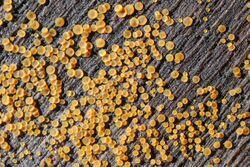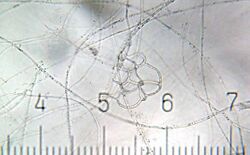Biology:Orbiliaceae
| Orbiliaceae | |
|---|---|

| |
| Orbilia xanthostigma | |
| Scientific classification | |
| Domain: | Eukaryota |
| Kingdom: | Fungi |
| Division: | Ascomycota |
| Subdivision: | Pezizomycotina |
| Class: | Orbiliomycetes O.E. Erikss. & Baral |
| Order: | Orbiliales Baral, O.E. Erikss., G. Marson & E. Weber |
| Family: | Orbiliaceae Nannf. (1932) |
| Type genus | |
| Orbilia Fr. (1836)
| |
| Genera | |
|
Arthrobotrys | |
The Orbiliaceae are a family of saprobic sac fungi in the order Orbiliales. The family, first described by John Axel Nannfeldt in 1932, contains 288 species in 12 genera.[1] Members of this family have a widespread distribution, but are more prevalent in temperate regions.[2] Some species in the Orbiliaceae are carnivorous fungi, and have evolved a number of specialized mechanisms to trap nematodes.
Description
Orbiliaceae do not have stromata, dense structural tissue that produces fruit bodies. They have small disc-shaped apothecia, that are typically convex, brightly colored or translucent.[2] Their ascospores are small (typically less than 10 x 1 μm), hyaline, and have an oval or ellipsoidal shape.[3] Species are usually found in wood on both wet and dry habitats.[2] Anamorph species are hyphomycetous.[4]
Nematophagy
This family is well known for its many nematophagous species.[5] Shortly after coming into contact with its prey, fungal mycelia penetrate the nematode and spontaneously differentiate into functional structures, known as traps, which will ultimately digest the nematode's internal contents.[6] There are 5 types of trap mechanisms recognized in this family:[6][7][8][9]
- Adhesive network: the most common trap, formed by hyphal outgrowths that recurve into themselves to form nematode-trapping loops.
- Adhesive knob: a roughly spherical cell, attached to the hyphae either directly or on an erect stalk. Adhesive knobs are typically closely spaced along a section of hyphae.
- Nonconstricting rings: always found with the adhesive network traps, and formed from thickening hyphae that curve and fuse to the supporting stalk.
- Adhesive column: a layer of cells on a hyphae with an adhesive surface.
- Constricting rings: these are rings of hyphae that swell rapidly inwards upon contact with the nematode, quickly (in 1–2 seconds) "lassoing" the victim.
Genera
According to the most recent classification of Ascomycota,[10] the Orbiliaceae contain only two (teleomorph) genera, the Hyalorbilia and the Orbilia. Hyalorbilia is distinguished from Orbilia by having asci without a stalk that arise from croziers, a hemispherical to broadly conical, thin-walled apex, asci and paraphyses in a gelatinous matrix, and an ectal excipulum (the outer surface of a cup-like apothecium) of horizontal textura prismatica.[11][12]
Anamorph genera of the Orbiliaceae include Anguillospora,[13] Arthrobotrys,[14] Dactylella,[15] Dactylellina, Dicranidion,[16] Drechslerella, Helicoön,[17] Monacrosporium, and Trinacrium. It has been suggested that the anamorph specialization illustrates convergent evolution occurring among mycelial fungi in aquatic and low-nitrogen habitats.[18] This hypothesis has been borne out by recent phylogenetic and morphological studies.[19]
In 2007, a new species was described from southwestern China with morphological features intermediate between Orbilia and Hyalorbilia. This species, named Pseudorbilia bipolaris Y. Zhang, Z.F. Yu, H.O. Baral & K.Q. Zhang, was placed into its own genus in the Orbiliaceae to accommodate its distinctive features.[20]
References
- ↑ Kirk, Paul M.; Cannon, Paul F.; Minter, David W. et al., eds (2008). "Orbiliaceae". Ainsworth & Bisby's Dictionary of the Fungi. CABI. p. 485. ISBN 978-0-85199-826-8. https://books.google.com/books?id=IFD4_VFRDdUC&pg=PA485.
- ↑ 2.0 2.1 2.2 Cannon, P. F.; Kirk, P. M., eds (2007). "Orbiliaceae". Fungal Families of the World. CABI. pp. 251–252. ISBN 978-0-85199-827-5.
- ↑ Introductory Mycology. New York: Wiley. 1996. ISBN 0-471-52229-5.[page needed]
- ↑ Ainsworth & Bisby's Dictionary of the Fungi. Oxon: CAB International. 2001. p. 369. ISBN 0-85199-377-X.
- ↑ Pfister, Donald H. (1997). "Castor, Pollux and life histories of fungi". Mycologia 89 (1): 1–23. doi:10.1080/00275514.1997.12026750.
- ↑ 6.0 6.1 Barron, George L. (1977). The Nematode-destroying Fungi. Guelph: Canadian Biological Publications. ISBN 0-920370-00-4.
- ↑ Yang, Ying; Yang, Ence; An, Zhiqiang; Liu, Xingzhong (15 May 2007). "Evolution of nematode-trapping cells of predatory fungi of the Orbiliaceae based on evidence from rRNA-encoding DNA and multiprotein sequences". Proceedings of the National Academy of Sciences of the United States of America 104 (20): 8379–8384. doi:10.1073/pnas.0702770104. PMID 17494736. Bibcode: 2007PNAS..104.8379Y.
- ↑ Drechsler, Charles (1 July 1937). "Some Hyphomycetes that Prey on Free-Living Terricolous Nematodes". Mycologia 29 (4): 447–552. doi:10.1080/00275514.1937.12017222.
- ↑ Stirling GR (1991). Biological control of plant parasitic nematodes. Wallingford, UK: C.A.B. International. ISBN 0-85198-703-6.[page needed]
- ↑ "Outline of Ascomycota - 2007". http://archive.fieldmuseum.org/myconet/outline.asp#classTaph.
- ↑ Baral, HO (1994). "Comments on 'Outline of the ascomycetes-1993'". Systema Ascomycetum 13 (1): 113–128. NAID 10014785631.
- ↑ Wu, Mei-Lee; Su, Yu-Chih; Baral, Hans-Otto; Liang, Shih-Hsiung (2007). "Two new species of Hyalorbilia from Taiwan". Fungal Diversity 25: 233–244. https://www.fungaldiversity.org/fdp/sfdp/25-14.pdf.
- ↑ Webster, J; Descals, E. (1979). "The teleomorphs of water-borne Hyphomycetes from fresh water". in Kendrick, Bryce. The Whole Fungus: The Sexual-asexual Synthesis. National Museum of Natural Sciences. pp. 419–451. ISBN 978-0-660-00146-3.
- ↑ Pfister, Donald H. (1 May 1994). "Orbilia fimicola, a nematophagous discomycete and its Arthrobotrys anamorph". Mycologia 86 (3): 451–453. doi:10.1080/00275514.1994.12026433.
- ↑ Thakur, S.; Zachariah, K. (1 November 1989). "Response of the fungus Dactylella rhopalota to bacteria". Plant and Soil 120 (1): 87–93. doi:10.1007/BF02370294.
- ↑ Korf, Richard P (1992). "A preliminary discomycete flora of Macaronesia: Part 8, Orbiliaceae". Mycotaxon 45: 503–510. INIST:4551685. http://www.cybertruffle.org.uk/cyberliber/59575/0045/0503.htm.
- ↑ Pfister, DH (1995). "Helicoon sessile, the anamorph of Orbilia luteorubella". Inoculum (Mycological Society of America) 46: 34.
- ↑ Webster, John (June 2011). "Convergent evolution and the functional significance of spore shape in aquatic and semi-aquatic fungi". in Rayner, A. D. M.; Brasier, C. M.; Moore, David. Evolutionary Biology of the Fungi: Symposium of The British Mycological Society Held at the University of Bristol April 1986. Cambridge University Press. pp. 191–201. NAID 10019290922. ISBN 978-0-521-27925-3.
- ↑ "Phylogenetics and evolution of nematode-trapping fungi (Orbiliales) estimated from nuclear and protein coding genes". Mycologia 97 (5): 1034–46. 2005. doi:10.3852/mycologia.97.5.1034. PMID 16596955.
- ↑ Zhang, Ying; Yu, Ze-Fen; Baral, H.-O.; Qiao, Min; Zhang, Ke-Qin (2007). "Pseudorbilia gen. nov. (Orbiliaceae) from Yunnan, China". Fungal Diversity 26: 305–312. https://www.fungaldiversity.org/fdp/sfdp/26-14.pdf.
External links
- Images of various Orbilia and Hyalorbilia species
- Videos of Arthrobotrys oligospora trapping nematodes
Wikidata ☰ Q1517480 entry
 |


